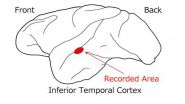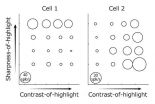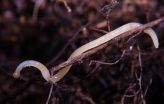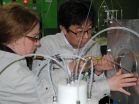(Press-News.org) Japanese researchers showed monkeys a number of images representing various glosses and then they measured the responses of 39 neurons by using microelectrodes. They found that a specific population of neurons changed the intensities of the responses linearly according to either the contrast-of-highlight, sharpness-of-highlight, or brightness of the object. This shows that these 3 perceptual parameters are used as parameters when the brain recognizes a variety of glosses. They also found that different parameters are represented by different populations of neurons. This was published in the Journal of Neuroscience (September 4, 2014 issue).
The gloss of an object surface provides information about the condition of that object. For instance, whether it is wet or dry, whether food is fresh or old. Several gloss-related physical parameters such as specular reflectance and diffuse reflectance have been described and used in computer graphics so far. However, the parameters used when neurons respond to gloss have not yet been found.
A Japanese research group led by Hidehiko Komatsu, professor of the National Institute for Physiological Sciences (NIPS), National Institutes of Natural Sciences (NINS), in collaboration with the Advanced Telecommunications Research Institute International (ATR) prepared 16 images representing various glosses and showed them to monkeys. In a circumscribed area in the inferior temporal cortex of the brain, neurons strengthened their responses proportionately as the contrast-of-highlight and/or sharpness-of-highlight got higher. Neural responses also vary greatly depending on the brightness, for instance, whether the object is black, gray, or white. Furthermore, the perceptual gloss parameters of the presented image could be fairly precisely predicted from the strengths of the population neural responses.
By the application of these findings in an artificial image recognition system, the researchers are expecting that it would be able to develop robots that recognize gloss like humans.
INFORMATION:
Neurons express 'gloss' using three perceptual parameters
2014-09-19
ELSE PRESS RELEASES FROM THIS DATE:
Environmental pollutants make worms susceptible to cold
2014-09-19
Imagine you are a species which over thousands of years has adapted to the arctic cold, and then you get exposed to a substance that makes the cold dangerous for you.
This is happening to the small white worm Enchytraeus albidus, and the cold provoking substance, called nonylphenol, comes from the use of certain detergents, pesticides and cosmetics.
Nonylphenol is suspected of being a endocrine disruptor, but when entering the worm it has another dangerous effect: It inhibits the worm's ability to protect the cells in its body from cold damage.
Enchytraeus albidus ...
Quick-change materials break the silicon speed limit for computers
2014-09-19
The present size and speed limitations of computer processors and memory could be overcome by replacing silicon with 'phase-change materials' (PCMs), which are capable of reversibly switching between two structural phases with different electrical states – one crystalline and conducting and the other glassy and insulating – in billionths of a second.
Modelling and tests of PCM-based devices have shown that logic-processing operations can be performed in non-volatile memory cells using particular combinations of ultra-short voltage pulses, which is not possible with silicon-based ...
Milestone in chemical studies of superheavy elements
2014-09-19
An international collaboration led by research groups from Mainz and Darmstadt, Germany, has achieved the synthesis of a new class of chemical compounds for superheavy elements at the RIKEN Nishina Center for Accelerator-based Research (RNC) in Japan. For the first time, a chemical bond was established between a superheavy element – seaborgium (element 106) in the present study – and a carbon atom. Eighteen atoms of seaborgium were converted into seaborgium hexacarbonyl complexes, which include six carbon monoxide molecules bound to the seaborgium. Its gaseous properties ...
Technique to model infections shows why live vaccines may be most effective
2014-09-19
Vaccines against Salmonella that use a live, but weakened, form of the bacteria are more effective than those that use only dead fragments because of the particular way in which they stimulate the immune system, according to research from the University of Cambridge published today in the journal PLOS Pathogens.
The BBSRC-funded researchers used a new technique that they have developed where several populations of bacteria, each of which has been individually tagged with a unique DNA sequence, are administered to the same host (in this case, a mouse). This allows the ...
How pneumonia bacteria can compromise heart health
2014-09-19
Bacterial pneumonia in adults carries an elevated risk for adverse cardiac events (such as heart failure, arrhythmias, and heart attacks) that contribute substantially to mortality—but how the heart is compromised has been unclear. A study published on September 18th in PLOS Pathogens now demonstrates that Streptococcus pneumoniae, the bacterium responsible for most cases of bacterial pneumonia, can invade the heart and cause the death of heart muscle cells.
Carlos Orihuela, from the University of Texas Health Science Center in San Antonio, USA, and colleagues initially ...
Human sense of fairness evolved to favor long-term cooperation
2014-09-19
VIDEO:
This is a video describing the ultimatum game in chimpanzees.
Click here for more information.
ATLANTA—The human response to unfairness evolved in order to support long-term cooperation, according to a research team from Georgia State University and Emory University.
Fairness is a social ideal that cannot be measured, so to understand the evolution of fairness in humans, Dr. Sarah Brosnan of Georgia State's departments of Psychology and Philosophy, the Neuroscience Institute ...
Nuclear spins control current in plastic LED
2014-09-19
SALT LAKE CITY, Sept. 18, 2014 – University of Utah physicists read the subatomic "spins" in the centers or nuclei of hydrogen isotopes, and used the data to control current that powered light in a cheap, plastic LED – at room temperature and without strong magnetic fields.
The study – published in Friday's issue of the journal Science – brings physics a step closer to practical machines that work "spintronically" as well as electronically: superfast quantum computers, more compact data storage devices and plastic or organic light-emitting diodes, or OLEDs, more efficient ...
Changes in coastal upwelling linked to temporary declines in marine ecosystem
2014-09-19
In findings of relevance to both conservationists and the fishing industry, new research links short-term reductions in growth and reproduction of marine animals off the California Coast to increasing variability in the strength of coastal upwelling currents — currents which historically supply nutrients to the region's diverse ecosystem.
Along the west coast of North America, winds lift deep, nutrient-rich water into sunlit surface layers, fueling vast phytoplankton blooms that ultimately support fish, seabirds and marine mammals.
The new study, led by Bryan Black ...
World population to keep growing this century, hit 11 billion by 2100
2014-09-19
Using modern statistical tools, a new study led by the University of Washington and the United Nations finds that world population is likely to keep growing throughout the 21st century. The number of people on Earth is likely to reach 11 billion by 2100, the study concludes, about 2 billion higher than some previous estimates.
The paper published online Sept. 18 in the journal Science includes the most up-to-date estimates for future world population, as well as a new method for creating such estimates.
"The consensus over the past 20 years or so was that world population, ...
Scientists discover 'dimmer switch' for mood disorders
2014-09-19
Researchers at University of California, San Diego School of Medicine have identified a control mechanism for an area of the brain that processes sensory and emotive information that humans experience as "disappointment."
The discovery of what may effectively be a neurochemical antidote for feeling let-down is reported Sept. 18 in the online edition of Science.
"The idea that some people see the world as a glass half empty has a chemical basis in the brain," said senior author Roberto Malinow, MD, PhD, professor in the Department of Neurosciences and neurobiology section ...




